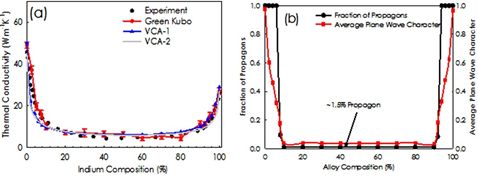npj: 细思声子——那个无序的问题
海归学者发起的公益学术平台
分享信息,整合资源
交流学术,偶尔风月
目前认为固体内的原子以集体运动的方式连续振动,其量子化幅度可以用所谓声子(一种准粒子)来描述。声子可看作原子振动的平面波/准粒子,能传播,可散射,既传热,又传声。而当处理包含无序的材料时,将声子当作能传播和散射的波便常常与事实不符。来自美国佐治亚理工学院的Asegun Henry等,通过关注声子相关性而不是散射,可以更准确地捕捉振动模式随材料无序度的变化。他们惊奇地发现,声子的特征在杂质浓度的前几个百分比范围内变化很大,超过这个百分比,声子的模式更像非晶材料的情形。该文近期发表于npj Computational Materials 3:49 (2017); doi:10.1038/s41524-017-0052-9
英文标题与摘要如下,点击阅读原文可以自由获取论文PDF。
Rethinking phonons: The issue of disorder
Hamid Reza Seyf, Luke Yates, Thomas L. Bougher, Samuel Graham, Baratunde A. Cola, Theeradetch Detchprohm, Mi-Hee Ji, Jeomoh Kim, Russell Dupuis, Wei Lv & Asegun Henry
Current understanding of phonons treats them as plane waves/quasi-particles of atomic vibration that propagate and scatter. The problem is that conceptually, when any level of disorder is introduced, whether compositional or structural, the character of vibrational modes in solids changes, yet nearly all theoretical treatments continue to assume phonons are still waves. For example, the phonon contributions to alloy thermal conductivity (TC) rely on this assumption and are most often computed from the virtual crystal approximation (VCA). Good agreement is obtained in some cases, but there are many instances where it fails—both quantitatively and qualitatively. Here, we show that the conventional theory and understanding of phonons requires revision, because the critical assumption that all phonons/normal modes resemble plane waves with well-defined velocities is no longer valid when disorder is introduced. Here we show, surprisingly, that the character of phonons changes dramatically within the first few percent of impurity concentration, beyond which phonons more closely resemble the modes found in amorphous materials. We then utilize a different theory that can treat modes with any character and experimentally confirm its new insights.
本文系网易新闻·网易号“各有态度”特色内容
媒体转载联系授权请看下方








